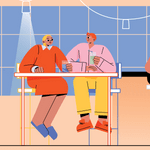What It’s Like to Live—and Date—With a Chronic Invisible Illness

Happily ever after, in my case, comes with a lot of question marks and medical terminology.
In marriage vows they talk about “in sickness and in health,” but when I got married at 21, I felt like that was more theoretical—down the road. Not today, but someday. I felt pretty healthy then, and I had no idea I would later be diagnosed with chronic conditions that would change my life, all after separating from my husband. Talk about a plot twist! Now, dating with disability as a 39-year-old single mom, the phrase has taken on a whole new meaning.
At first, I didn’t understand what was going on with my body. Symptoms built gradually like a rising crescendo, until I was overwhelmingly uncomfortable. Tests gave few answers. I had underlying conditions like migraine, tremor, and asthma that were related, but it took a while to connect the dots. My easy bruising was blamed on my pale complexion. I worried that doctors would blame my weight, so I didn’t press the issue until the pain was unbearable. Finally, I found a doctor who believed me and knew right away what was to blame.
What I can say now is that I have hypermobile Ehlers Danlos syndrome, chronic idiopathic urticaria (hives) and ADHD inattentive type. All together, these conditions can make life a little more complicated—work, parenting and dating included. You can’t tell any of this just by looking at me, but I’m self-conscious just the same.
I bring more to the table than blister packs of medication. I’m also a loving mom to a teenage boy and a successful business owner, and I’m pretty funny. I can’t cook, but my son once said I’m good at making the elevator smell like pizza delivery. I am resilient, innovative and strong. I am proud of my Indigenous cultural heritage and the advocacy work I undertake on behalf of my people. But eventually, when I’m getting to know someone new, I have to explain what my daily life is like: lots of focus on self-care, doctor appointments and listening to my body.
And when you’re living with a degenerative condition, you have to talk about how it might impact a future life together. Osteoarthritis is also something that’s common with my condition, and my joint degenerations will worsen over time. (I’m supposed to be getting regular X-rays to monitor deterioration in my feet and hands.) My symptoms may also increase during and after menopause. Happily ever after, in my case, comes with a lot of question marks and medical terminology.
I know my health challenges don’t define me, but it’s still hard. I know all too well the judgment that can come with admitting or disclosing “imperfect” health, so I really think about who I share what with, and when. Sometimes I feel like it would be better up front, because I don’t want to waste time with someone who isn’t up for the adventure that is being my boyfriend. Other times, I would like to let someone get to know the good, the bad and the hilarious over time, and then choose for themselves.
Handle with care
Hypermobile Ehlers-Danlos syndrome (hEDS) complicates even the simplest show of affection: holding hands can be exciting and scary. My joints pop out because my body makes collagen poorly, and that’s a building block of connective tissue.
Connective tissue is everywhere in the body: your joints, skin, heart, digestive system, internal organs. When the tissues are too stretchy and fragile, it can cause problems. This is why hEDS can affect your blood vessels, cause pre-term labour and make having surgery more complicated. I’ve had joints pop out while I was washing my hands, standing in the shower, walking across the street, trying to eat a sandwich and rolling over in bed. I sometimes feel light-headed, and I had a hard time working in a traditional nine-to-five job, because getting accommodated in the workplace (before I was officially diagnosed) was challenging.
It makes pretty much every aspect of life harder, all because my body is a little too bendy and everything is a little too loose. I have struggled with depression caused by the pain of swelling and dislocations. While we all look for flexibility in a partner, in some cases it can actually be a detriment. “It’s kind of like dating Mrs. Potatohead,” I explain. “Miss, actually.”
I’ve had an online dating profile on and off for years, and I have found a few long-term relationships this way. But more active date nights can be risky for me, and when you live on the west coast, where everyone wants to go hiking and do outdoorsy things, it’s really hard. It might be something to explore with someone I trust, but I don’t want to literally fall apart on a first date. I can’t always walk far because of the dislocations, hiking uneven terrain is stressful, and I am at risk of falling on snow and ice.
When I share why I can’t say yes to these more adventurous invites, sometimes I’m asked what else I can’t do. I get awkward questions about whether my hEDS interferes with my sex life, because potential partners are worried about injuring me. I’m all for being honest, but it does hurt when someone looks at you as if being close or intimate might be a bad thing.
As my disease has progressed over the years, the things I enjoyed most have been ripped away, and I have felt so alone because fitness was also how I connected with friends—not just with dates. The risk of injury meant no more Zumba, no more pole dance, no more hot yoga or spin class. It changed old relationships, and it impacts finding new ones, too.
Itching for connection
My chronic idiopathic urticaria can be a bit of a mystery for others to understand. The hives make me itchy, but my triggers are complex: I can’t just avoid a specific food. It’s exacerbated by stress, fatigue, being too hot or cold, having my skin scratched or wearing anything too tight. My lips swell, my cheeks flush and I feel like they’re burning from the inside. I also feel anxious because I can’t trust my body and its reactions. The most awkward part is how the hives are very noticeable on my chest—it is not the kind of attention I want to draw to my cleavage.
Hives might not seem like a big deal, but the condition means having allergic reactions almost daily, being exhausted from the side effects of antihistamines, waiting and waiting to see an allergist in the public system and feeling very alone struggling against a condition that only affects roughly 1 percent of the population. The daily struggle of it—while advocating to be believed, and to have my discomfort validated—is also maddening. It can randomly resolve on its own, or it can be very resistant to treatment and last for years. Many doctors don’t know much about the condition, and those who weren’t successful in treating it with previous patients tend not to be optimistic.
The treatment for my severe urticaria is a drug called Xolair, which can cost as much as $18,000 a year—almost the same as the rent on my two-bedroom apartment. I’ve been learning the hard way how difficult it can be to get funding for the costs of living with a rare disease. I thought if I could just get through the nine-month wait to see an allergist I would be better in no time, but two months of paperwork later, I’m still trying to get my first dose covered. The manufacturer has a generous patient assistance program, but the remaining balance is still quite high.
Hives suck up your energy, make you uncomfortable in your own skin and can be so unpredictable, which makes planning dates or outings difficult. When I’m in a flare, I don’t want to go anywhere. I just want to rest, and I don’t want to be touched. But if you cancel on a date too many times when you’re getting to know someone, they think you’re flaky. Because I can’t control when I’m going to have an allergic reaction, I do the best I can.
In a relationship with distraction
My ADHD—which disproportionately affects people with joint hypermobility—brings its own stigma, because many of its expressions are viewed as moral failings, or qualities you wouldn’t want in a partner. Losing track of time, being disorganized, and forgetting things can suggest that you don’t care about others. The decision to medicate or not has brought its own judgments and “helpful suggestions” from people I’ve dated, like: have I considered a to-do list or a planner? (Thank goodness “Kyle-who-enjoys-hiking-and-the-colour-blue” is here to present an obvious solution to my neurodivergence!) Potential partners assume I’m just not trying hard enough, and it can be a dealbreaker if the person you are dating doesn’t support your treatment plan.
Looking forward, looking back
The reality is that none of us know what our health journey is going to look like. You can think you’re perfectly healthy one day and find out the next day you’re not. We all get old—if we’re lucky. I already know up front what some of my challenges are, though I may end up with new ones. It’s taken me years to understand that while I might be itchy, distracted and literally disjointed sometimes, I am still worthy of love, care and concern.
Sometimes I grieve how easy it used to be, back when I could have active hobbies and would spend 10 hours at the gym every week doing Zumba and spin, and teaching pole dance. Back then, I couldn’t even spell urticaria. I didn’t know that not everyone’s joints pop out, and that not being able to remember things wasn’t just an endearing hot-mess-mom thing. I didn’t really know what was going on with my health, but I had fewer things to be self-conscious about.
I may never get to the “in sickness and in health” marriage vows again, and that’s okay. Whether some nice man decides to take me from Miss to Mrs. Potatohead, I’m going to be just fine, but I’m still hopeful. I’m optimistic that I will find someone who will want to be part of my world, to be my emergency contact—and to share in the pizza deliveries. And, until then, I just have to keep being flexible (because that’s what I do best!).




